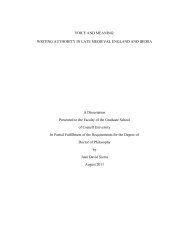Dissertation FINAL2.pdf - Cornell University
Dissertation FINAL2.pdf - Cornell University
Dissertation FINAL2.pdf - Cornell University
Create successful ePaper yourself
Turn your PDF publications into a flip-book with our unique Google optimized e-Paper software.
the complex play of focalization that results as the reader’s perspective shifts between<br />
potential interpreters with conflicting sympathies. 57<br />
More recently, Raymond Marks<br />
has skillfully elucidated the relationship between Silius’ ekphrasis and its principal<br />
model: Aeneas’ reading of the murals on the temple of Juno at Carthage in Aeneid 1. 58<br />
The reaction of Hannibal to what he sees, however, owes rather more to the<br />
architectural fantasy at the beginning of Georgics 3: 59 having observed an artistic<br />
representation of the events of the First Punic War from the Roman perspective,<br />
Hannibal unveils his plans for a rival set of temple murals, to be realized in Carthage,<br />
which will tell the story of the Second Punic War from the Carthaginian perspective: 60<br />
quae postquam infesto percensuit omnia uultu<br />
arridens Poenus, lenta proclamat ab ira:<br />
“non leuiora dabis nostris inscribere tectis<br />
acta meae dextrae: captam, Carthago, Saguntum<br />
da spectare, simul flamma ferroque ruentem;<br />
perfodiant patres natorum membra. nec Alpes<br />
exiguus domitas capiet locus; ardua celsis<br />
persultet iuga uictor equis Garamasque Nomasque.<br />
addes Ticini spumantis sanguine ripas<br />
et nostrum Trebiam et Thrasymenni litora Tusci<br />
clausa cadaueribus. ruat ingens corpore et armis<br />
57 Fowler (1996) 57-74, esp. 65-71. On the problems of reading ecphrasis, see Fowler’s seminal article<br />
(Fowler (1991)) with exhaustive bibliography.<br />
58 Marks (2003) 128-44. On the description of artwork in Silius, see also Frank (1974) and Augoustakis<br />
(2003).<br />
59 Some of the parallels between Punica 6 and Georgics 3 are noted by Fowler (1996) 72-73.<br />
60 The probable lexical parallels are highlighted. domitas in line 704 and addes in line 706 pick up<br />
Georgics 3.30 (addam urbes Asiae domitas). Less secure is the resemblance in sound between flamma<br />
ferroque ruentem at line 702 and Georgics 3.28 (atque hic undantem bello magnumque fluentem). Note<br />
too the allusion to the columns adorned with ships’ beaks that will appear on the doors of Vergil’s<br />
temple (Georgics 3.29) at Punica 6.664: rostra gerens niuea surgebat mole columna, noticed by Fowler<br />
(note 3 above) 67, n. 37 (“the proem to Georgics 3 is ‘a significant ekphrastic intertext’”).<br />
23
















